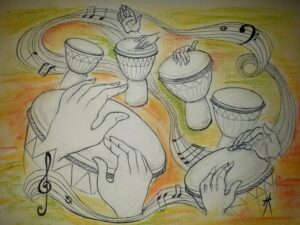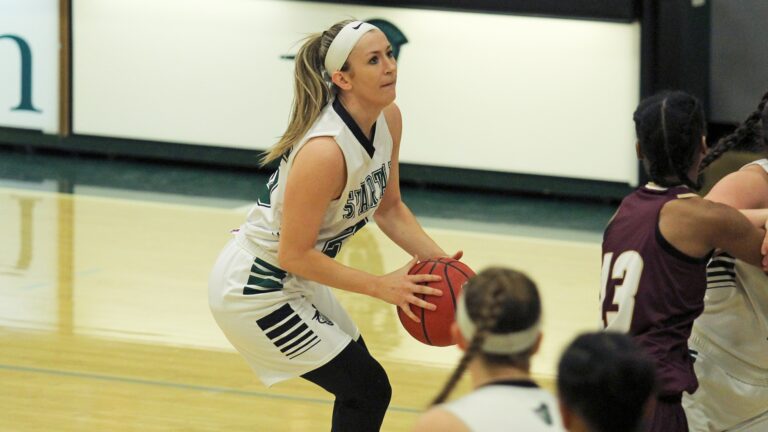Djembe drums connect music to soul

Music has the power to heal deep traumas, to connect us to ourselves and with our fellow humans of past, present and future.
I was reminded of this after a powerful experience in professor Jared Shapiro’s Global Music course. Guest speaker Gary Meitrott visited the class on Jan. 28 armed with a van full of djembe hand drums, a popular West African instrument. Meitrott is the founder of the Rutland-based group, Drum Journeys of Earth, and offers his 20 years of experience with ethnic drumming, having studied with masters from West Africa, Latin America and the Middle East.
Once a Broadway actor, his vibrant energy shook the early 9 a.m. class awake, and quickly. Prior to teaching the class various rhythms, Meitrott delivered a poignant message about the need to return to our primordial roots and to our bodies in the present moment (unplugged), as well as the importance of generational wisdom and individual autonomy.
Drumming is a primordial music. Drums were among the first instruments to be made by humankind, and were used for communicating over long distances and in ancient rituals and ceremonies.
The djembe drum was invented approximately 400 to 800 years ago by Mande people in West Africa. The creation of djembe drums was a spiritual process initially carried out only by blacksmiths.
Crafted specifically for each musician, djembe drums were carved from a solid tree trunk with an animal skin stretched over the top. The tradition of djembe playing in West Africa was reserved for those born into families of djembe musicians, who are entrusted with passing down the oral history of their people.
There is said to be three spirits within the djembe; the spirit of the tree from which it was carved, from the animal whose skin makes the membrane, and of the carver who cut the tree and who created the drum. It is straddled between the thighs and at an angle so that when hit, the sound may resonate through the instrument and into the air. The hand directly strikes the membrane in three basic ways; bass, with the palm striking the center of the drum; tone, which uses the upper palm and fingers at the edge of the drum; and a slap, which uses the figures at the edge of the drum to create the highest pitch, he said.
As we learned how to strike the drum and some basic traditional rhythms, Meitrott spoke of the importance of community. In today’s digital age, the definition of community has evolved to unite niches of people across the world who never meet or speak in person. While the transnationality of the modern world is essential, so too is to unplug, live in the present and connect with all generations in our local community, he said.
In western culture, older generations are often forgotten, shuffled into nursing homes once they are no longer able to contribute to the workforce. There is an obsession with youth that undermines the wisdom to be learned from elders who have lived rich lives filled with experience of a world quite different to ours. Consider that we now have access to an enormous variety of music to stream 24/7, when generations of the past experienced music only at sporadic events and with no choice as to the genre.
To drive his emphasis on the importance of inter-generational community, the rhythms he taught the class were separated into three groups: the grandparents, the parents and the youth.
The ‘grandparents’ began drumming first and laid down the fundamental structure of the song, as they provide the starting point for generations to come. The ‘parents,’ whose phrase grew out of the grandparents, provided harmony and increased the complexity. ‘The youth’ came in last with a more quickly paced beat dancing atop the other two rhythms, completing the song.
Urging the class to bring the sound up out of the ground, the communal sound we created truly resonated. There was a pure joy in the air as inhibitions melted away and we made this music together. Perhaps it is because of my own personal love of drumming, but I left that workshop with a buzzing energy that lasted the entire day.
I felt that this experience was worth sharing with the greater student body because our fast-paced modern world of constantly evolving technology means we forget to live in the present moment. In this supposed ‘land of the free,’ we are still neatly shuffled into pre-existing social roles that prohibit genuine freedom. Playing an ancient instrument and creating beautiful music with a room full of unknown others, I felt totally present and connected in a deeply human way that surpasses time and place.
A poignant comment Meitrott made regarding a college education was that its purpose is to teach abstract and critical thought, that we may somehow give back to our community. To go deeper beyond the first thought that occurs, to challenge preconceptions and develop a sense of autonomy. This is more important now than ever, to keep truth and integrity grounding our humanity.
Our duty as students in higher education and as world citizens is to find our rhythm and give back to the community what we’ve discovered so that present and future generations may flourish.








